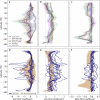Global decline in net primary production underestimated by climate models
- PMID: 39897660
- PMCID: PMC11785529
- DOI: 10.1038/s43247-025-02051-4
Global decline in net primary production underestimated by climate models
Abstract
Marine net primary production supports critical ecosystem services and the carbon cycle. However, the lack of consensus in the direction and magnitude of projected change in net primary production from models undermines efforts to assess climate impacts on marine ecosystems with confidence. Here we use contemporary remote sensing net primary production trends (1998-2023) from six remote sensing algorithms to discriminate amongst fifteen divergent model projections. A model ranking scheme, based on the similarity of linear responses of net primary production to changes in sea surface temperature, chlorophyll-a and the mixed layer, finds that future declines in net primary production are more likely than presently predicted. Even the best ranking models still underestimate the sensitivity of declines in net primary production to ocean warming, suggesting shortcomings remain. Reproducing this greater temperature sensitivity may lead to even larger declines in future net primary production than presently considered for impact assessment.
Keywords: Marine biology.
© The Author(s) 2025.
Conflict of interest statement
Competing interestsThe authors declare no competing interests.
Figures




Similar articles
-
The Minderoo-Monaco Commission on Plastics and Human Health.Ann Glob Health. 2023 Mar 21;89(1):23. doi: 10.5334/aogh.4056. eCollection 2023. Ann Glob Health. 2023. PMID: 36969097 Free PMC article. Review.
-
Next-generation ensemble projections reveal higher climate risks for marine ecosystems.Nat Clim Chang. 2021;11(11):973-981. doi: 10.1038/s41558-021-01173-9. Epub 2021 Oct 21. Nat Clim Chang. 2021. PMID: 34745348 Free PMC article.
-
Twenty-first-century climate change impacts on marine animal biomass and ecosystem structure across ocean basins.Glob Chang Biol. 2019 Feb;25(2):459-472. doi: 10.1111/gcb.14512. Epub 2018 Dec 1. Glob Chang Biol. 2019. PMID: 30408274
-
From global to regional and back again: common climate stressors of marine ecosystems relevant for adaptation across five ocean warming hotspots.Glob Chang Biol. 2016 Jun;22(6):2038-53. doi: 10.1111/gcb.13247. Epub 2016 Mar 21. Glob Chang Biol. 2016. PMID: 26855008 Free PMC article.
-
Impacts of global warming on marine microbial communities.Sci Total Environ. 2021 Oct 15;791:147905. doi: 10.1016/j.scitotenv.2021.147905. Epub 2021 May 21. Sci Total Environ. 2021. PMID: 34126492 Review.
References
-
- Bindoff, N. L. et al. Changing Ocean, Marine Ecosystems, and Dependent Communities. In IPCC Special Report on the Ocean and Cryosphere in a Changing Climate (eds. Pörtner, H.-O. et al.) 477–587 (Intergovernmental Panel on Climate Change, 2019).
-
- IPCC. Climate Change 2021: The Physical Science Basis. Contribution of Working Group I to the Sixth Assessment Report of the Intergovernmental Panel on Climate Change. (Cambridge University Press, Cambridge, United Kingdom and New York, USA, 2021).
-
- Tagliabue, A. et al. Persistent Uncertainties in Ocean Net Primary Production Climate Change Projections at Regional Scales Raise Challenges for Assessing Impacts on Ecosystem Services. Front. Clim.3, 10.3389/fclim.2021.738224 (2021).
-
- Kwiatkowski, L. et al. Twenty-first century ocean warming, acidification, deoxygenation, and upper-ocean nutrient and primary production decline from CMIP6 model projections. Biogeosciences17, 3439–3470 (2020).
LinkOut - more resources
Full Text Sources
